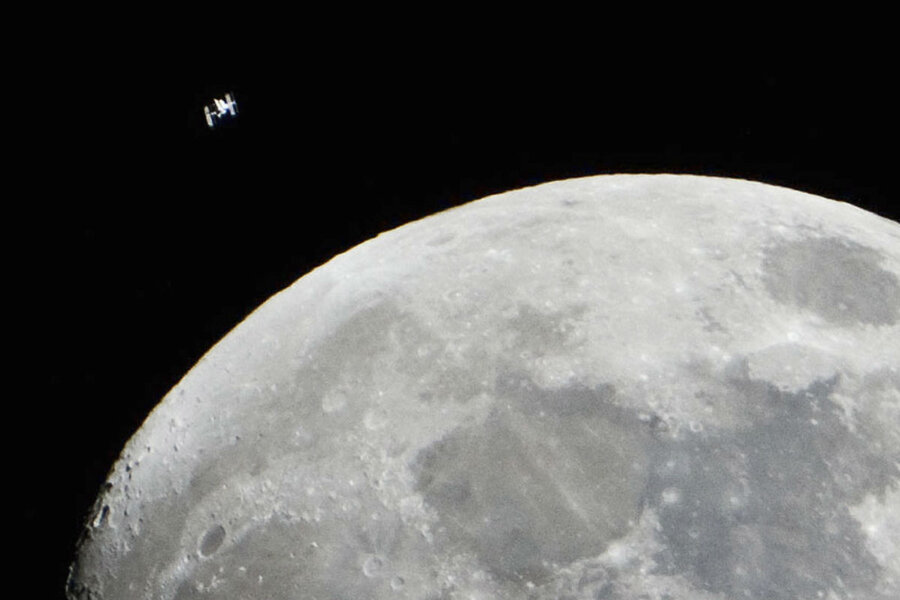ISS 2.0: Why the next space station could orbit the moon
Loading...
Dominating the night sky, Earth’s natural satellite is often the first target to catch the eye of budding astronomers, and now the moon's siren call is pulling the world’s leading space powers too.
The five space agencies responsible for building the International Space Station (ISS) met last month in Tsukuba, home to the Japanese space agency JAXA, to decide what comes after the aging ISS. Discussions advanced an evolving plan to build a lunar space station, settling on a tentative orbit and paving the way for finalized plans that may come in late 2017 or early 2018.
But friction remains around the ultimate goal of the station: Will the ISS successor be a truly lunar space station or a spaceport on the way to Mars?
With the ISS’s decommissioning tentatively scheduled for 2024, the International Spacecraft Working Group (ISWG), composed of the American, Russian, Japanese, European, and Canadian space agencies, is looking ahead to the next phase of human space exploration.
This year’s meeting extends work done last year in Houston, when the team established a number of non-binding recommendations regarding technical details likely to serve as the foundation for future proposals.
Compared with the ISS, a space station orbiting the moon holds greater scientific potential and the opportunity to test technologies needed for deep space missions, but poses significant challenges.
Much of the research done aboard the current ISS focuses on microgravity (commonly, if mistakenly, known as "zero gravity"), which arises from the craft being in a constant state of freefall. A lunar station could carry out similar studies of microgravity phenomena and astronaut health, with the added benefit of lunar proximity making the moon an additional target of study.
What’s more, the station could play an essential role as a steppingstone to Mars, both as a physical spaceport accessible to NASA’s upcoming Orion spacecraft, as well as a scientific testing ground for new deep-space technologies. Japanese- and European-built habitats featuring closed-loop life support systems could be one such development. The ISS currently relies on frequent shipments of water and oxygen from Earth, but a less accessible lunar station would likely have no such luxury. For a Mars mission, near-perfect recycling of these resources will be even more of a necessity.
Some wonder why not build a base on the moon itself, rather than a station in orbit. It’s true that a base could be more easily shielded from harmful radiation by piling up yards of moondust over the habitats. But extensive lunar construction would require unproven technologies as opposed to the tried and true modular approach to space station building.
Moreover, escaping Earth’s gravitational pull takes fuel, and the same is true of the moon. Breaking free and staying in orbit, rather than making repeated visits to the surface, may be more efficient.
The ISWG has set the goal of developing common standards that will make it easy for various countries to develop “plug and play” parts to smooth the construction process. Current designs call for a Russian airlock, the Canadian robotic arm from the ISS, and US-built power and propulsion systems.
Still, the question looms, where is humanity headed next? Russia wants to return to the moon’s surface, which a station in a low lunar orbit would support. But a higher orbit lends itself to Mars access, an approach preferred by NASA, who reportedly proposed naming the station a "spaceport."
Last month’s conference seems to have broken NASA’s way, with the consortium agreeing on a distant loop known as a Near-Rectilinear Halo Orbit. As the name suggests, this oval path bulges significantly.
At its closest approach, the craft would be only 900 miles from the moon, but its farthest reach would take it 43,000 miles from the surface, completing a revolution in one week. That’s 4 to 174 times higher from the lunar surface than the ISS sits above the Earth’s.
In addition to being convenient to Mars, this orbit features a number of advantages including constant sun for solar panels, good communication with Earth, and stability that reduces the need for expensive fuel-consuming height boosts.
Unfortunately, it’s not ideal for actually visiting the surface of the moon, prompting the Russians to continue their analysis of a lower orbit station.
But NASA may be open to compromise and is reportedly considering designs for a station that could split in two, one part bound for Mars and one remaining to service lunar activity. Another alternative is to modify the orbit as needed for different missions.
The current timeline suggests construction throughout the 2020s in preparation for Mars- or asteroid-oriented expeditions in the 2030s, although the group's previous construction project suffered significant delays.
Any new ISS in lunar orbit may have company. China’s nascent but booming space program recently announced plans for a 2036 crewed lunar mission, and private companies are targeting the satellite as well. Space habitat company Bigelow Aerospace envisions an inflatable space station orbiting the moon by 2020, and SpaceX harbors ambitions of an Apollo 8-style shot around the moon in the next couple of years.








